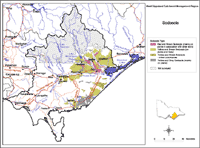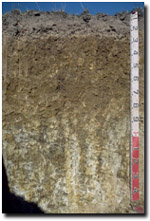Sodosols
Sodosols (Australian Soil Classification) have a strong texture contrast between loamy surface (A) horizons and clayey subsurface (B) horizons. The subsoils are sodic (i.e. exchangeable sodium percentage is 6 or greater) and not strongly acid (i.e. pH 5.5 or lower).
Sodosols can be separated on the basis of the colour of the upper 20 cm of the subsoil into Red, Brown, Yellow, Grey and Black groups. Further separations are made largely on the basis of the soil's chemical characteristics.
 Sodosols in the West Gippsland Region |
This overview map of Sodosols in the West Gippsland region has been developed from more detailed regional soil/landform mapping (Sargeant and Imhof, In press). It shows areas where Sodosols are most likely to occur within the region and should only be used as a general indication of their distribution. Note that other soil types may also occur within these mapped areas. Also, some areas (e.g. forested areas in the north of the region) have been largely unsurveyed and the distribution of soil types is not well known. |
 Yellow Sodosol that occurs on older terraces near Briagolong. |
Sodosols are most common in the eastern (lower rainfall zone) part of the region. They occur on Tertiary sediments and on the extensive alluvial plains and river terraces deposited during the Pleistocene Period - east of Traralgon, north and south of the LaTrobe River and around Yarram. The soils on the oldest alluvial plains are mostly Brown and Yellow Sodosols. |


